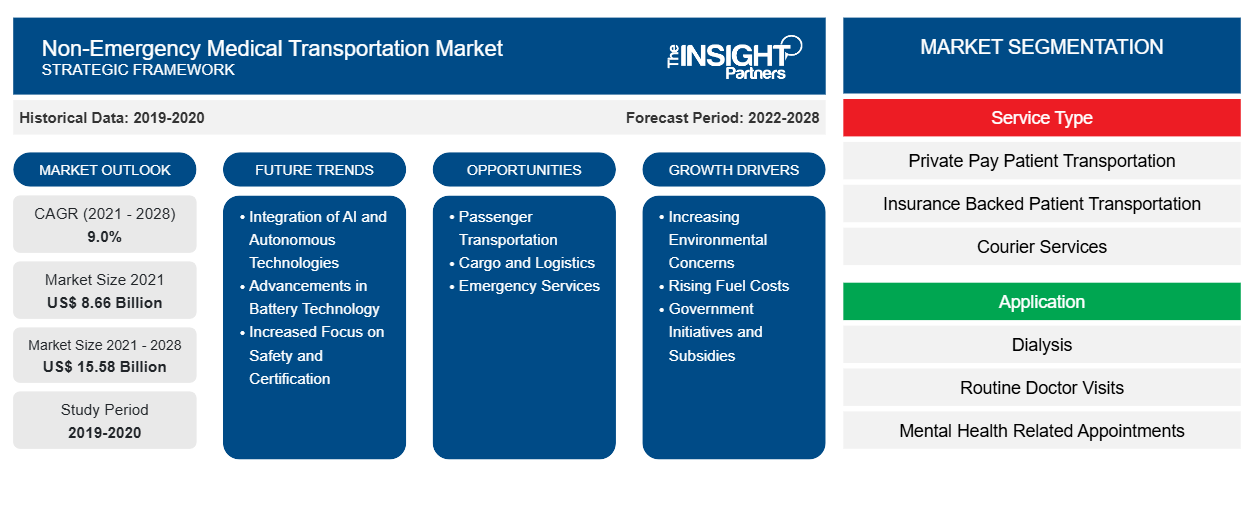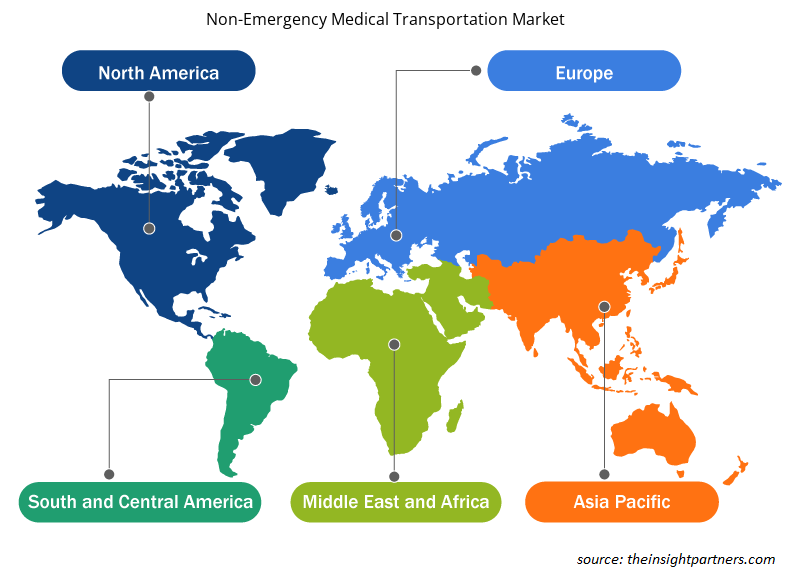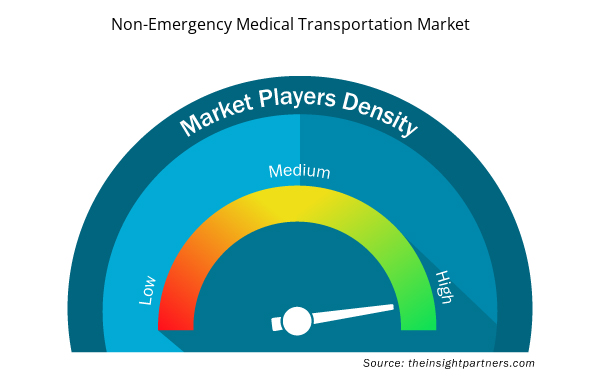非紧急医疗运输市场规模预计将从2024年的167.148亿美元增至2031年的318.7249亿美元。预计2025年至2031年期间,该市场的复合年增长率将达到9.7 %。非紧急医疗运输技术的进步可能会在未来几年为市场带来新的趋势。
非紧急医疗运输市场分析
推动非紧急医疗运输市场发展的因素包括非紧急医疗运输需求的不断增长,以及老龄化人口中慢性病发病率的激增。此外,非紧急医疗运输领域的技术发展预计将促进市场增长。市场参与者的战略举措预计将在未来几年创造充足的机遇。
非紧急医疗运输市场概览
预计北美将主导非紧急医疗运输市场,而亚太地区预计将出现显著增长率,这归因于老年人群中慢性病患病率的上升以及对改进的医疗保健解决方案的需求不断增长。不断增加的医疗保健支出和医疗保健基础设施的发展,以及激增的医疗旅游业,也增加了这些地区对非紧急医疗运输的需求。在亚太地区,中国占据主要市场份额,而印度在该地区的增长速度显著。中国计划在未来几年投资 1.5 万亿美元,进一步推进其医疗技术创新。除了“健康中国 2030”计划外,这笔支出还旨在通过技术进步和医疗保健系统的改善来确保中国国内的健康公平。根据民政部和中国老龄问题全国委员会的报告,中国是世界上老龄人口最多的国家之一。 2023年,中国60岁及以上人口超过2.97亿,占总人口的21.1%。中国老年人口面临的慢性病负担日益加重,高龄是导致疾病发生的首要危险因素。根据2024年发表在《英国医学杂志》 (BMJ)上的研究报告《中国慢性病未满足的需求》,非传染性疾病(NCDs)是中国最严重的健康威胁,占所有死亡人数的91%。中国主要的NCDs包括心血管疾病(43%)、癌症(23%)和糖尿病( 2%)。
定制此报告以满足您的要求
您可以免费定制任何报告,包括本报告的部分内容、国家级分析、Excel 数据包,以及为初创企业和大学提供优惠和折扣
非紧急医疗运输市场:

- 获取此报告的顶级关键市场趋势。此免费样品将包括数据分析,从市场趋势到估计和预测。
非紧急医疗运输市场驱动因素和机遇
非紧急医疗运输需求不断增长
根据美国医院协会的数据,每年约有360万美国人因交通问题(交通不便、距离医疗机构较远、公共交通基础设施不足以及交通费用高昂)而无法获得必要的医疗服务。加州大学戴维斯分校健康中心的一项研究表明,每年约有580万美国人因交通不便而错过或延误医疗服务。交通是导致错过医疗预约的一个重要因素。凯撒医疗集团2019年的一项调查发现,三分之一的美国人经常或偶尔会因交通问题而感到压力。
自1965年以来,医疗补助(Medicaid)一直包含非紧急医疗运输(NEMT)福利,医疗补助覆盖的人群将获得运输服务作为一项基本福利。根据医疗补助登记和解除追踪数据,截至2023年4月,共有约9400万人登记了医疗补助。肯尼迪基金会(KFF)医疗补助预算调查预计,2021年美国医疗保健会员人数将增长8.2%,这主要得益于新冠疫情危机和失业率上升。随着越来越多的人获得医疗补助,对NEMT服务的需求也将直接增加。
美国大多数州已转型通过 NEMT 经纪人或管理式医疗组织 (MCO) 提供 NEMT 服务。在许多州,经纪人或 MCO 按人头收费来监督 NEMT 服务,而其他州(包括内华达州、亚利桑那州和佛蒙特州)则通过当地服务提供商按服务收费提供 NEMT 服务。儿童健康保险计划 (CHIP) 通过医疗补助计划 (Medicaid) 和单独的 CHIP 项目为符合条件的儿童提供医疗保险。CHIP 由各州根据联邦要求管理,并由州和联邦政府共同出资。因此,随着政府此类举措的增多,对 NEMT 的需求也在不断增长,从而推动市场增长。
NEMT和交通网络公司的战略举措为市场增长创造了充足的机会
NEMT 公司和交通网络公司 (TNC) 渴望采取战略行动,以改善医疗服务的可及性。Uber 或 Lyft 等 TNC 以其按需叫车功能和用户友好的移动应用程序而闻名。这些功能可以有效解决 NEMT 服务的可用性和调度问题。目前,各种 TNC 正在开发新平台,或与 NEMT 以及全球各地的个人医疗服务提供商开展合作。一些州政府机构允许 TNC 提供 NEMT 服务。以下列举一些示例。
- 2024年6月,Uber正式推出Uber Health平台,旨在帮助患者就诊,从而减少缺席率并提高准时率。该平台符合《健康保险流通与责任法案》(HIPAA),为传统出租车服务提供了一种经济高效的替代方案,尤其有利于缺乏专用交通资源的小型医疗机构。Uber专注于医疗保健的平台覆盖美国250多个城市,显著拓宽了NEMT(新英格兰医疗服务)的覆盖范围。
- 2024年1月,CTG合作伙伴公司MediDrive正式进军NEMT市场。该公司致力于解决患者往返医疗预约和手术的复杂交通问题。
- 2022年6月,MTM推出Elevate计划,提供主动的行程管理。MTM采取主动的方式为Elevate计划的会员管理行程,为复杂的旅程提供礼宾级服务,并满足会员独特的交通需求。
- 2022年2月,Modivcare Inc. 推出了 Modivcare 学院。这项创新计划旨在通过提供教育资源、交流机会和培训,为 NEMT 地区的交通运输服务提供商提供帮助。该项目以独特的方式为交通运输服务提供商提供必要的业务工具、最佳实践和培训,以有效地支持对美国最弱势群体的照护。
这些战略举措旨在提高服务效率,提升患者可及性,降低运营成本,并确保与医疗保健服务更好地融合。随着新英格兰医学、医学和医学医学(NEMT)行业的持续发展,这些举措对于在全球范围内拓展服务范围、提升患者护理质量至关重要。
非紧急医疗运输市场报告细分分析
有助于得出非紧急医疗运输市场分析的关键部分是服务类型、设施、应用和最终用户。
- 根据服务类型,非紧急医疗运输市场细分为自费病人运输、保险支持病人运输、快递服务及其他。自费病人运输在2024年占据了最大的市场份额,预计在2024年至2031年期间将实现最高的复合年增长率。
- 按设施类型划分,非紧急医疗运输市场分为设施内运输和设施间运输。2024年,设施间运输占据了更大的市场份额,预计在2024年至2031年期间,该市场的复合年增长率将更高。
- 按应用领域划分,非紧急医疗运输市场可细分为透析、常规就诊、心理健康相关预约、康复及其他。2024年,心理健康相关预约领域占据了最大的市场份额;预计康复领域将在2024年至2031年期间实现最高的复合年增长率。
- 就最终用户而言,非紧急医疗运输市场细分为医院和诊所、疗养院、家庭护理机构、行动管制令期间和政府机构、医疗保健支付方以及其他。医院和诊所在2024年占据市场主导地位,而疗养院市场预计将在2024年至2031年期间实现最高的复合年增长率。
非紧急医疗运输市场份额(按地区)分析
非紧急医疗运输市场报告的地理范围主要分为五个地区:北美、亚太、欧洲、中东和非洲、南美和中美。
2023年,北美占据了相当大的市场份额。非紧急医疗运输市场的增长归因于各种疾病的日益流行、非紧急医疗运输(NEMT)保险覆盖范围的扩大,以及各州对这些服务作为行政或医疗费用的报销率较高。此外,以患者为中心的护理模式的转变、对NEMT认识的提高以及技术进步也是支撑市场增长的其他因素。慢性疾病、年老、残疾、受伤和肥胖只是美国人依赖非紧急医疗运输服务的众多原因中的几个。疫情催生了对可靠的汽车交通工具的巨大需求,以便人们前往预约就诊、进行必要的就诊和接受日常治疗。此外,老年人口的增加也促进了美国非紧急医疗运输市场的增长。此外,在该市场运营的公司正在采用有机和无机发展战略来拓展市场。以下是一些相关的例子:
- 总部位于马萨诸塞州的私营医疗运输公司 Coastal Medical Transportation Systems (CMTS) 于 2022 年 9 月收购了 Transformative Healthcare 的医疗运输部门。该部门旗下包括 LifeLine 救护车服务 (LifeLine Ambulance Service) 和 Fallon 救护车服务 (Fallon Ambulance Service)。此次收购使 CMTS 成为该州最大的救护车网络之一,无论就服务的患者数量还是覆盖的地理区域而言。
- 2022 年 9 月,Baystate Wing 医院与 Quaboag Connector 合作,为马萨诸塞州的医疗保健机构提供交通服务。这项路边到路边服务提供 NEMT 服务,方便患者预订往返 Baystate Wing 医院各医疗机构的诊疗预约。
非紧急医疗运输市场区域洞察
Insight Partners 的分析师已详尽阐述了预测期内影响非紧急医疗运输市场的区域趋势和因素。本节还讨论了北美、欧洲、亚太地区、中东和非洲以及南美和中美洲的非紧急医疗运输市场细分和地域分布。

- 获取非紧急医疗运输市场的区域具体数据
非紧急医疗运输市场报告范围
| 报告属性 | 细节 |
|---|---|
| 2024年的市场规模 | 167.148亿美元 |
| 2031年的市场规模 | 318.7249亿美元 |
| 全球复合年增长率(2025-2031) | 9.7% |
| 史料 | 2021-2023 |
| 预测期 | 2025-2031 |
| 涵盖的领域 | 按服务类型
|
| 覆盖地区和国家 | 北美
|
| 市场领导者和主要公司简介 |
|
非紧急医疗运输市场参与者密度:了解其对业务动态的影响
非紧急医疗运输市场正在快速增长,这得益于终端用户需求的不断增长,而这些需求的驱动因素包括消费者偏好的演变、技术进步以及对产品优势的认知度的提升。随着需求的增长,企业正在扩展产品线,不断创新以满足消费者需求,并抓住新兴趋势,从而进一步推动市场增长。
市场参与者密度是指特定市场或行业内企业或公司的分布情况。它表明特定市场空间内竞争对手(市场参与者)的数量相对于其规模或总市值而言。
在非紧急医疗运输市场运营的主要公司有:
- MTM公司
- 抗肿瘤药物
- Xpress 交通
- CJ医疗运输
- 维瑞达
免责声明:以上列出的公司没有按照任何特定顺序排列。

- 获取非紧急医疗运输市场顶级关键参与者概览
非紧急医疗运输市场新闻和最新发展
非紧急医疗运输市场评估是通过收集一手资料和二手资料后进行的定性和定量数据进行的,这些数据包括重要的企业出版物、协会数据和数据库。以下列出了非紧急医疗运输市场的一些发展情况:
- Modivcare Inc. 推出了其突破性的数字平台 Integration Hub,旨在彻底改变享有 NEMT 福利的 Medicaid 和 Medicare 会员的参与度和体验。Modivcare 的 Integration Hub 是业内首个提供可扩展模块化移动平台的平台,该平台向其商业健康计划客户、州医疗补助机构和机构合作伙伴开放开放的应用程序编程接口 (API)。(来源:ModivCare,公司网站,2024 年 5 月)
- 美国最大的私营 NEMT 经纪公司 MTM 与 Global Medical Response 签署协议,收购 Access2Care, LLC。此次战略性收购显著提升了 MTM 的市场占有率,并增加了年度总收入,标志着公司增长轨迹上的一个里程碑。收购 Access2Care 的 NEMT 业务是经过深思熟虑后做出的,符合 MTM 的战略扩张计划。(来源:MTM, Inc,公司网站,2024 年 8 月)
- Acadian Ambulance Service 宣布已签署协议,将全面收购 SouthernCross Ambulance 的全部资产。SouthernCross Ambulance 是一家位于德克萨斯州新布朗费尔斯的紧急医疗服务 (EMS) 提供商。此次收购将使 Acadian 能够额外运营 12 辆救护车和 10 辆轮椅车,并招募新员工。SouthernCross Ambulance 为德克萨斯州中南部和南部地区提供紧急和非紧急救护车运输服务,包括往返医院、康复中心、诊所、疗养院和专业护理中心的本地和长途救护车运输。(来源:Acadian Ambulance Service,公司网站,2024 年 1 月)
非紧急医疗运输市场报告覆盖范围和交付成果
“非紧急医疗运输市场规模和预测(2021-2031)”报告对以下领域进行了详细的市场分析:
- 非紧急医疗运输市场规模以及全球、区域和国家层面涵盖范围内所有关键细分市场的预测
- 非紧急医疗运输市场趋势以及市场动态,例如驱动因素、限制因素和关键机遇
- 详细的 PEST 和 SWOT 分析
- 非紧急医疗运输市场分析涵盖主要市场趋势、全球和区域框架、主要参与者、法规和最新市场发展
- 行业格局和竞争分析,包括市场集中度、热图分析、知名参与者以及非紧急医疗运输市场的最新发展
- 详细的公司简介
- 历史分析(2 年)、基准年、预测(7 年)及复合年增长率
- PEST 和 SWOT 分析
- 市场规模价值/数量 - 全球、区域、国家
- 行业和竞争格局
- Excel 数据集



Report Coverage
Revenue forecast, Company Analysis, Industry landscape, Growth factors, and Trends

Segment Covered
This text is related
to segments covered.

Regional Scope
North America, Europe, Asia Pacific, Middle East & Africa, South & Central America

Country Scope
This text is related
to country scope.
常见问题
The global non-emergency medical transportation market is estimated to register a CAGR of 9.7% during the forecast period.
The estimated value of the non-emergency medical transportation market can reach US$ 31,872.49 million by 2031.
North America dominated the non-emergency medical transportation market in 2024.
The increasing increasing need for non-emergency medical transportation and surging incidence of chronic conditions among aging populations. arethe most influential factors responsible for the market growth.
MTM, Inc.; AMR; Xpress Transportation; CJ Medical Transportation; VERIDA; ModivCare; Crothall Healthcare; Elite Medical Transport; Acadian Ambulance Service; Transdev; Ride Health; Roundtrip; Medical Answering Services, LLC; One Call; Stellar Transport; Abba Medical Transportation, LLC; Able Medical Transportation, Inc.; Life Ride; Mobility Transportation Services, Inc.; and ABC Non-Emergency Medical Transportation, LLC are among the key players operating in the non-emergency medical transportation market.
Trends and growth analysis reports related to Life Sciences : READ MORE..
The List of Companies - Non-Emergency Medical Transportation Market
- MTM, Inc.
- AMR
- Xpress Transportation
- CJ Medical Transportation
- VERIDA
- ModivCare
- Crothall Healthcare
- Elite Medical Transport
- Acadian Ambulance Service
- Transdev
- Ride Health
- Roundtrip
- Medical Answering Services, LLC
- One Call
- Stellar Transport
- Abba Medical Transportation, LLC
- Able Medical Transportation, Inc.
- Life Ride
- Mobility Transportation Services, Inc.
- ABC Non-Emergency Medical Transportation, LLC
The Insight Partners performs research in 4 major stages: Data Collection & Secondary Research, Primary Research, Data Analysis and Data Triangulation & Final Review.
- Data Collection and Secondary Research:
As a market research and consulting firm operating from a decade, we have published and advised several client across the globe. First step for any study will start with an assessment of currently available data and insights from existing reports. Further, historical and current market information is collected from Investor Presentations, Annual Reports, SEC Filings, etc., and other information related to company’s performance and market positioning are gathered from Paid Databases (Factiva, Hoovers, and Reuters) and various other publications available in public domain.
Several associations trade associates, technical forums, institutes, societies and organization are accessed to gain technical as well as market related insights through their publications such as research papers, blogs and press releases related to the studies are referred to get cues about the market. Further, white papers, journals, magazines, and other news articles published in last 3 years are scrutinized and analyzed to understand the current market trends.
- Primary Research:
The primarily interview analysis comprise of data obtained from industry participants interview and answers to survey questions gathered by in-house primary team.
For primary research, interviews are conducted with industry experts/CEOs/Marketing Managers/VPs/Subject Matter Experts from both demand and supply side to get a 360-degree view of the market. The primary team conducts several interviews based on the complexity of the markets to understand the various market trends and dynamics which makes research more credible and precise.
A typical research interview fulfils the following functions:
- Provides first-hand information on the market size, market trends, growth trends, competitive landscape, and outlook
- Validates and strengthens in-house secondary research findings
- Develops the analysis team’s expertise and market understanding
Primary research involves email interactions and telephone interviews for each market, category, segment, and sub-segment across geographies. The participants who typically take part in such a process include, but are not limited to:
- Industry participants: VPs, business development managers, market intelligence managers and national sales managers
- Outside experts: Valuation experts, research analysts and key opinion leaders specializing in the electronics and semiconductor industry.
Below is the breakup of our primary respondents by company, designation, and region:

Once we receive the confirmation from primary research sources or primary respondents, we finalize the base year market estimation and forecast the data as per the macroeconomic and microeconomic factors assessed during data collection.
- Data Analysis:
Once data is validated through both secondary as well as primary respondents, we finalize the market estimations by hypothesis formulation and factor analysis at regional and country level.
- Macro-Economic Factor Analysis:
We analyse macroeconomic indicators such the gross domestic product (GDP), increase in the demand for goods and services across industries, technological advancement, regional economic growth, governmental policies, the influence of COVID-19, PEST analysis, and other aspects. This analysis aids in setting benchmarks for various nations/regions and approximating market splits. Additionally, the general trend of the aforementioned components aid in determining the market's development possibilities.
- Country Level Data:
Various factors that are especially aligned to the country are taken into account to determine the market size for a certain area and country, including the presence of vendors, such as headquarters and offices, the country's GDP, demand patterns, and industry growth. To comprehend the market dynamics for the nation, a number of growth variables, inhibitors, application areas, and current market trends are researched. The aforementioned elements aid in determining the country's overall market's growth potential.
- Company Profile:
The “Table of Contents” is formulated by listing and analyzing more than 25 - 30 companies operating in the market ecosystem across geographies. However, we profile only 10 companies as a standard practice in our syndicate reports. These 10 companies comprise leading, emerging, and regional players. Nonetheless, our analysis is not restricted to the 10 listed companies, we also analyze other companies present in the market to develop a holistic view and understand the prevailing trends. The “Company Profiles” section in the report covers key facts, business description, products & services, financial information, SWOT analysis, and key developments. The financial information presented is extracted from the annual reports and official documents of the publicly listed companies. Upon collecting the information for the sections of respective companies, we verify them via various primary sources and then compile the data in respective company profiles. The company level information helps us in deriving the base number as well as in forecasting the market size.
- Developing Base Number:
Aggregation of sales statistics (2020-2022) and macro-economic factor, and other secondary and primary research insights are utilized to arrive at base number and related market shares for 2022. The data gaps are identified in this step and relevant market data is analyzed, collected from paid primary interviews or databases. On finalizing the base year market size, forecasts are developed on the basis of macro-economic, industry and market growth factors and company level analysis.
- Data Triangulation and Final Review:
The market findings and base year market size calculations are validated from supply as well as demand side. Demand side validations are based on macro-economic factor analysis and benchmarks for respective regions and countries. In case of supply side validations, revenues of major companies are estimated (in case not available) based on industry benchmark, approximate number of employees, product portfolio, and primary interviews revenues are gathered. Further revenue from target product/service segment is assessed to avoid overshooting of market statistics. In case of heavy deviations between supply and demand side values, all thes steps are repeated to achieve synchronization.
We follow an iterative model, wherein we share our research findings with Subject Matter Experts (SME’s) and Key Opinion Leaders (KOLs) until consensus view of the market is not formulated – this model negates any drastic deviation in the opinions of experts. Only validated and universally acceptable research findings are quoted in our reports.
We have important check points that we use to validate our research findings – which we call – data triangulation, where we validate the information, we generate from secondary sources with primary interviews and then we re-validate with our internal data bases and Subject matter experts. This comprehensive model enables us to deliver high quality, reliable data in shortest possible time.

 获取此报告的免费样本
获取此报告的免费样本